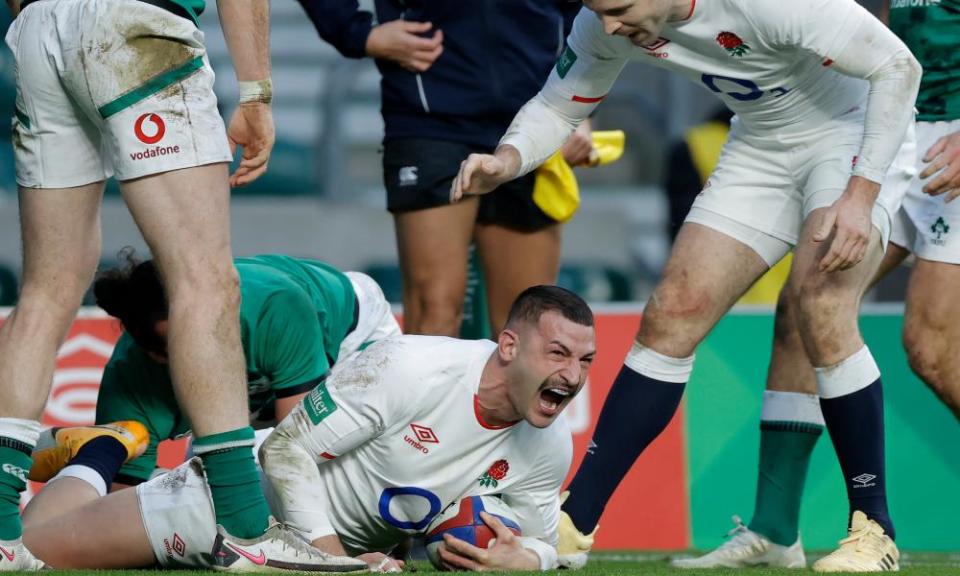Rugby union's charms buried under defensive landslide in Nations Cup
Common ground is hard to find these days. Whether it be politics, the climate crisis or sport, there is generally a hardcore prepared to argue that, actually, black is white or down is up, even if overwhelming evidence exists to the contrary. The exception is rugby union, where creeping unease about the game as an uplifting spectacle is now virtually universal.
Take the Autumn Nations Cup, conceived as a means of cheering everyone up in the absence of the usual November Test schedule. From the Covid cancellations to the stultifying defence-obsessed “action” it has largely had the opposite effect, with people starting to point at the emperor and question his new clothes. If the final between England and France at Twickenham on Sunday is another dud, few could blame Amazon Prime for concluding its subscribers should be spared further punishment.
Related: Wayne Pivac angry with refereeing decisions after Wales' loss to England
This is absolutely not a gratuitous swipe at the players, who are mostly just doing what their coaches tell them and have mortgages to pay. Nor is it to overlook these weird coronavirus times: is this really the best moment to assess a sport’s health as it rattles around in cold, empty European stadiums, desperately trying to pay the spiralling bills?
But let’s be honest: if you were asked to stitch together a highlights package of this tournament to date how much would you find beyond Jonny May’s improbable score for England against Ireland? And even allowing for the odd connoisseur’s delight – how good was Sam Underhill against Wales, what a joy it is to watch France’s Antoine Dupont – does that entirely excuse the boil-in-the-bag drabness of the rest of it?
Of course there are still blessed exceptions but the fabulous jolt of electricity Japan delivered to last year’s Rugby World Cup is fast being replaced by a collective ennui. Virtually every national coach has come to a similar conclusion: defences are so hard to pierce, back rows so physical and midfields so packed that, counterintuitively, it makes life easier to give the ball to the opposition. The first half of the Premiership game between Newcastle and Sale on Friday was so dispiriting it almost made Mrs Brown’s Boys seem watchable.

The litany of problems is hardly a secret. Caterpillar rucks, reset scrums, the frequent pursuit of contact rather than space, the herds of replacements, the seemingly nonexistent offside line, the cricked necks as yet another ball disappears skywards … rugby’s traditional crooked-nose beauty and charm are being buried beneath a landslip of tactical ugliness. Even those international coaches – Gregor Townsend, Wayne Pivac – who have flirted with something more expansive are having to accept the realities of the era.
Related: England face Autumn Nations Cup final mismatch against depleted France
It is not just the breakdown, with its latched-on jacklers and frightening clear-outs, that is scarring the game but the widespread conclusion that hoisting the ball aloft offers a more reliable and quicker way of making ground than any amount of fancy backline trickery. No one is saying every match needs eight tries and minimal tackling but what is lacking – in addition to the atmosphere-enhancing crowds – is that all-important balance between risk and reward: some light to complement the shade.
At this rate urgent law changes will be unavoidable, whether it be banning the box-kick outside a defending side’s 22 until two sets of hands have touched the ball or cutting the number of subs a team can employ to five or six to free up slightly more space. If short-range kicks to the corner, even from a penalty, were to result in a lineout throw for the defending team, might that cause attacking teams to opt for something other than a series of close-range drives?
Anything that militates against sides simply stringing a line of 13 defenders across the pitch – whether that be via the 50/22 rule currently being trialled or something more radical – or reduces the dead time eaten up by scrums or kickers gazing at the goalposts also has to be a good thing.
Throwing the baby out with the bathwater should clearly be avoided, as Underhill – “If you don’t like scrums and lineouts go and watch rugby league” – was quick to stress following England’s underwhelming 24-13 win over Wales. As the man of the match’s teammate Ben Youngs explained, however, even making line breaks is now a recipe for becoming isolated and losing the ball at the next breakdown. “Previously if you made a line break all the odds were on you to go and finish it,” said the scrum-half. “Now the breakdown is so fiercely contested that after any line break I almost feel we’re more vulnerable than in any other part of the game.”
There, in a nutshell, is rugby’s nightmare before Christmas: even a flash of elusive brilliance by a gifted runner is now, potentially, bad news. To exacerbate the situation, the political tug of war between the French federation and the Top 14 clubs is set to mean Les Bleus are represented by a shadow XV for the autumn’s supposed centrepiece. No pressure on those involved but, image-wise, Test rugby can ill afford another turkey of a contest.

 Yahoo Movies
Yahoo Movies 